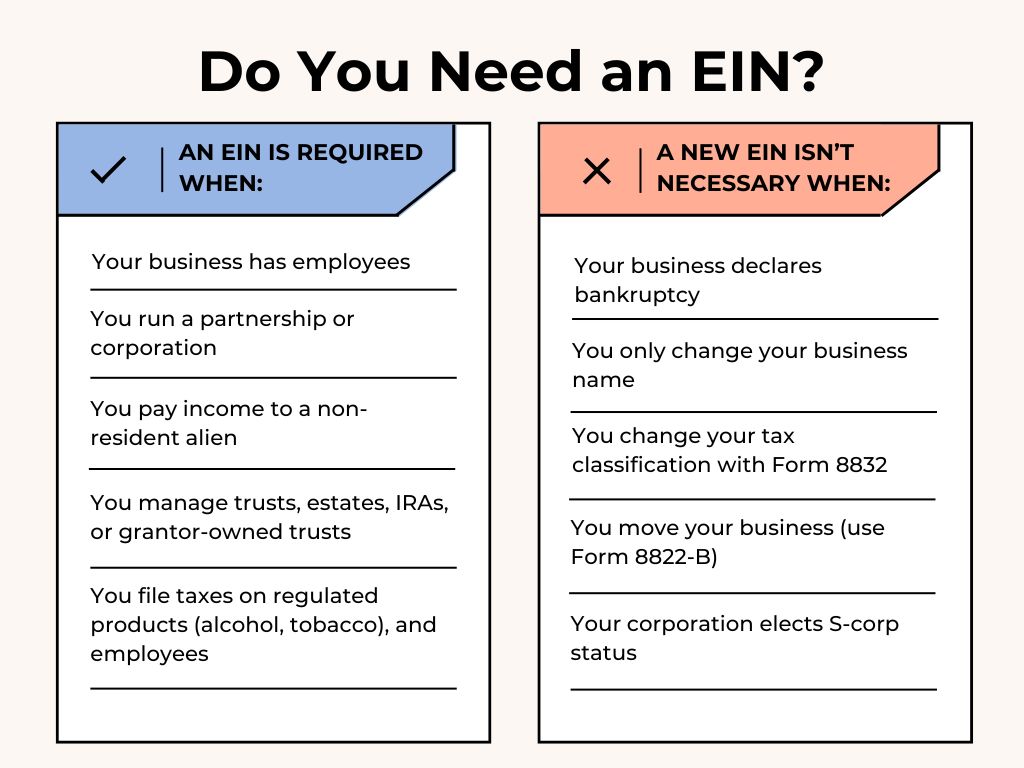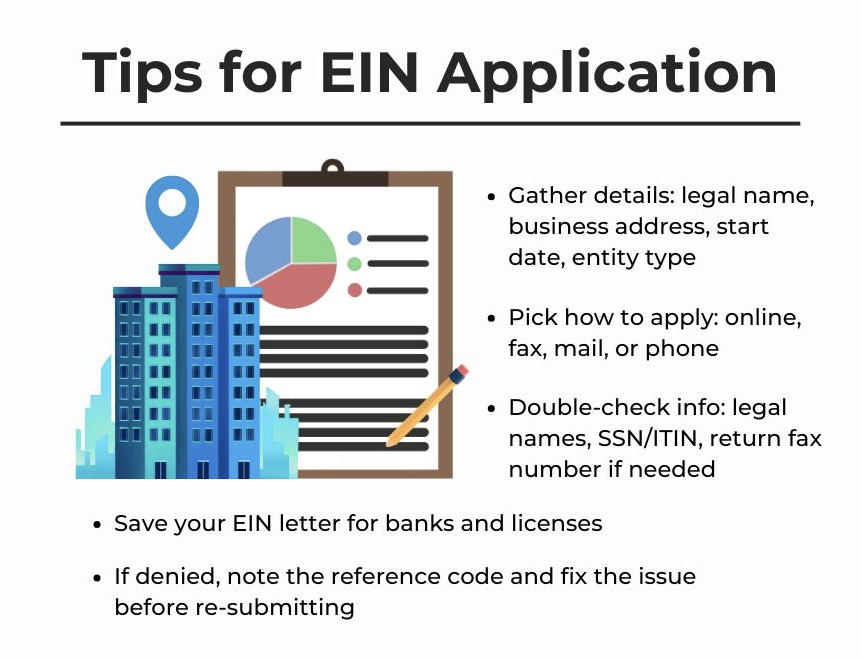Simply put, a tax ID is used by the IRS to track taxes for individuals and businesses. For instance, when you file your personal taxes, you use a Social Security number so the IRS can connect the return to you as an individual.
Businesses need something similar — an employer identification number (EIN). While the application process for your tax ID is usually straightforward, mistakes or mismatches can cause your business to be denied from getting a tax ID.
In this article, you’ll learn whether you really need a tax ID for your business, why EIN applications get denied, and how to make sure your business gets approved.
Do All Businesses Need an Employer Identification Number?
An EIN, often called a federal tax ID, isn’t necessary for every business. However, the IRS requires an EIN or tax ID for:
- Corporations and partnerships
- Multi-member LLCs
- Businesses with employees
- Trusts, estates, and nonprofit organizations
For single-member LLCs or sole proprietorships, filing taxes with a Social Security number is usually enough.
However, if you’re a non-US resident who’s planning to run a business in the US, you must have an EIN to handle federal tax obligations or open accounts.

Image via Author
Also Read:
- Sole Proprietorship vs S Corp: Pros and Cons of Each
- How Many People are Required to Form a Corporation?
Common Reasons Why Your EIN May Be Denied
For the most part, the IRS will approve your EIN application. However, there are some instances where you might find your EIN application getting denied.
If you’re wondering why you can’t get an EIN online, use this checklist to find out why.
Business Name Conflict (Reference 101 Error)
One of the most common reasons that you can’t get an EIN online is due to a Reference 101 error. This occurs when you have a conflict with your name on the application.
Entity names must be unique. Your state agency should ensure that your business name hasn’t already been taken when you initially file for your corporation or LLC.
Missing information might also cause a 101 error. Location problems, such as listing a different state for your physical address from that of your incorporation, might cause an error. Having more than one state on your EIN application might increase your chances of an error.
Existing EIN
Another common reason for getting a denial when you apply for an EIN is that your business entity already has one. You only need one EIN per business, unless certain large-scale changes happen, such as changing your entity structure.
For example, if you originally received your EIN as a sole proprietorship and recently changed to an LLC, you must apply for a new EIN. If you’ve simply forgotten your EIN, you can fill out an application to find it.
Daily Limit Rule (Reference 105)
The IRS has a daily limit rule that says only one EIN can be issued per responsible party per day. The “responsible party” is basically the main person in charge of the business.
If that same person tries to get more than one tax ID within 24 hours, the system automatically blocks it, and the application gets denied. Also, if you keep hitting “submit” online multiple times in a day, you’ll get automatically blocked.
You’ll need to wait at least 24 hours before reapplying, or use Form SS-4 by fax or mail.
Other Reference Error Codes
Besides references 101 and 105, the IRS has several other codes that explain why you can be denied from getting a tax ID:
- Responsible-Party Mismatch (Reference 102, 103, 108): If the name and SSN/ITIN of the person in charge don’t exactly match IRS records, the system can deny you from getting a tax ID.
- Third-Party Designee Conflict (Reference 104): A “designee” is someone you authorized to deal with the IRS for you, such as a lawyer or filing service. If their contact details are the same as the business’s, the IRS rejects it, and you can be denied from getting a tax ID.
- System Errors (Reference 109 to 113): This happens when the IRS system itself is down or overloaded. Your information is fine, but the tool can’t process it. Wait and try again, or send Form SS-4 by fax or mail.
For the most part, when you apply for an EIN online, it shouldn’t be denied as long as you have all of the right forms and information.
Also Read:
Tips to Avoid Your EIN Getting Denied
The IRS gives you three direct ways to apply:
However, many business owners also use third-party filing services like GovDocFiling. Whichever method you choose, the basic steps to apply for an EIN or tax ID remain the same.
1. Gather the Right Information First
After determining if you’re eligible to apply for an EIN, pull together the necessary details and documents the IRS requires, including:
- Legal entity name
- Trade name (DBA)
- Principal business address
- Business start date
- Entity type
- Reason for applying
- Number of employees
- Responsible party’s legal name plus SSN or ITIN
Note that the responsible party must always be a person, not another company. Skipping or mismatching even one field means you can be denied from getting a tax ID.
2. Choose the Correct Filing Method
You have three official routes:
- The online IRS portal issues a tax ID instantly, but only works if you have a US address and a valid SSN/ITIN.
- Faxing Form SS-4 takes about four business days if you provide a return fax number, while mailing it back can take several weeks.
- International applicants can’t use the portal. They must apply by phone or fax through the IRS.
3. Complete the Application Accurately
Use your legal name exactly as it appears in your records. Type the TIN in the proper format. Don’t copy identical details into both the business and third-party designee sections.
If faxing, always include a return number. Even small mistakes here cause you to be denied from getting a tax ID.
4. Submit and Track Your Status
Expect instant approval and reply online, a few days by fax, or weeks by mail. Save the tax ID confirmation letter, as banks and state agencies will request it.
5. Handle Reference Numbers or Denials
If you receive a reference code or a denial notice, record it exactly to effectively fix the issue. Sometimes, you’ll need to resubmit Form SS-4 or provide other forms to overturn the decision.
Once approved, you can use your tax ID immediately. However, keep your bank and business licenses updated, and if your address or responsible party changes, notify the IRS with Form 8822-B.

Image via Author
Also Read:
- EIN Reference Number 101: What It Is and How to Resolve It
- Partnership vs S Corp: Everything You Need to Know
FAQ
1. Why would the IRS deny my EIN application?
You can be denied from getting a tax ID if your business name conflicts with another, your responsible party’s SSN/ITIN doesn’t match IRS records, or you’ve already applied for an EIN. Technical issues, such as the one-EIN-per-day rule, can also cause your application to be denied.
2. Can someone without a Social Security Number apply for an EIN?
Yes, non-US residents can apply using Form SS-4 by fax, mail, or phone. They don’t need an SSN but must list a responsible party with an ITIN or foreign identification.
3. Does the IRS ever deny ITIN or EIN requests permanently?
No, denials are usually caused by errors or missing information. You can fix the issue and reapply. However, in rare cases, fraud or misuse may block issuance.
4. What disqualifies a business from getting an EIN?
Technically, nothing, since every legal business type qualifies. However, with mistakes like wrong entity type, duplicate applications, or mismatched details, you can be denied from getting a tax ID until corrected.
5. How long does it take to get an EIN in 2025?
Online approval is immediate if no errors occur. Fax takes about four business days, while mail can take four weeks or more. International applications usually take longer.
Getting an EIN is completely free; however, if you use an online filing service, you only pay for the service.
Conclusion
Applying for an EIN in 2026 doesn’t have to be stressful, but even minor mistakes can mean you can be denied from getting a tax ID. Most denials happen because of mismatched details, duplicate filings, or other reference code errors.
However, these are fixable, as long as you gather the right information, choose the correct filing method, and follow IRS instructions closely.
You can also get help from an online filing service so you can focus on growing and running your business.
